Table of Contents
What are the best eCommerce analytics tools? Metrics are everything when it comes to running an effective eCommerce business. From fine-tuning your sales messages to figuring out the quality of your traffic, marketers today are expected to understand their companies by the numbers.
That’s exactly why you shouldn’t waste your time on anything but the best eCommerce analytics tools to track your storefront’s day-to-day performance. Read on for our countdown of the best tools.
Marketers often find themselves in a bit of bind, though. We see moving pieces of our crucial eCommerce metrics and don’t know where to start in terms of tracking them all.
Sure, we all want to improve our conversions and create repeat customers. But how do we know what’s working and what’s not? And how do we make sense of our numbers without drowning in a sea of data?
eCommerce analytics refer to the collection, analysis, and interpretation of data related to online retail activities. These analytics encompass various metrics such as website traffic, conversion rates, sales performance, customer behavior, and marketing effectiveness.
By leveraging tools like Google Analytics, businesses can gain insights into customer preferences, identify trends, optimize marketing strategies, improve user experience, and ultimately enhance their online sales performance.
Through a combination of quantitative data and qualitative analysis, eCommerce analytics empower businesses to make informed decisions to drive growth and maximize profitability in the digital marketplace.
eCommerce analytics tools can significantly benefit your business by providing valuable insights into customer behavior, sales performance, and marketing effectiveness. These tools allow you to track key metrics such as website traffic, conversion rates, customer demographics, and product performance.
By analyzing this data and using an ELT solution, you can identify trends, understand customer preferences, and optimize your online store for better user experience.
These tools enable you to measure the ROI of your marketing campaigns, identify opportunities for growth, and make informed decisions to drive revenue and profitability in the digital marketplace. Additionally, utilising Python web scraping techniques can help you gather competitive data and customer feedback from external sources, further enhancing your ability to optimise your strategies.
Overall, leveraging eCommerce analytics tools empowers your business to enhance its online presence, increase sales, and stay competitive in the ever-evolving eCommerce landscape.
Navigating through these metrics can be daunting, but consulting with an experienced eCommerce expert can provide invaluable guidance in interpreting data and crafting tailored strategies aligned with business objectives.
Which analytics matter most in the realm of eCommerce? For online businesses, several metrics hold significant importance, some of which include:
When selecting an eCommerce analytics tool for your business, several key factors should be considered to ensure you choose the most suitable option.
By carefully assessing these factors and comparing different eCommerce analytics tools, you can make an informed decision that best serves your business’s analytical needs and strategic objectives:
If you’re struggling to make sense of your eCommerce data, don’t freak out. Chances are you haven’t quite found the right fit in terms of analytics tools, right?
Or even worse: you feel like you’re staring at a wall of numbers instead of clear, actionable advice.
You’re not alone. After all, analytics tools are not created equal in terms of complexity, accessibility and price tag. That’s why we’ve broken down the absolute best eCommerce analytics tools to get you started crunching your numbers sooner rather than later. In short, these tools can help you…
Each of the following tools ticks the boxes of what modern eCommerce marketers need. Regardless of your budget or industry, any combination of these tools is fair game.
So, let’s dive right in!
It’s hard to resist the allure of “free,” isn’t it?
Some of the best eCommerce analytics tools are indeed free thanks to the likes of Google. Considering that any given site is already using Google Analytics, using the platform to align with your eCommerce goals is a no-brainer. It’s worth noting that the latest version of Google Analytics (GA4) is quite different to it’s previous iterations, that being said it remains one of the most crucial resources for eCommerce analytics.
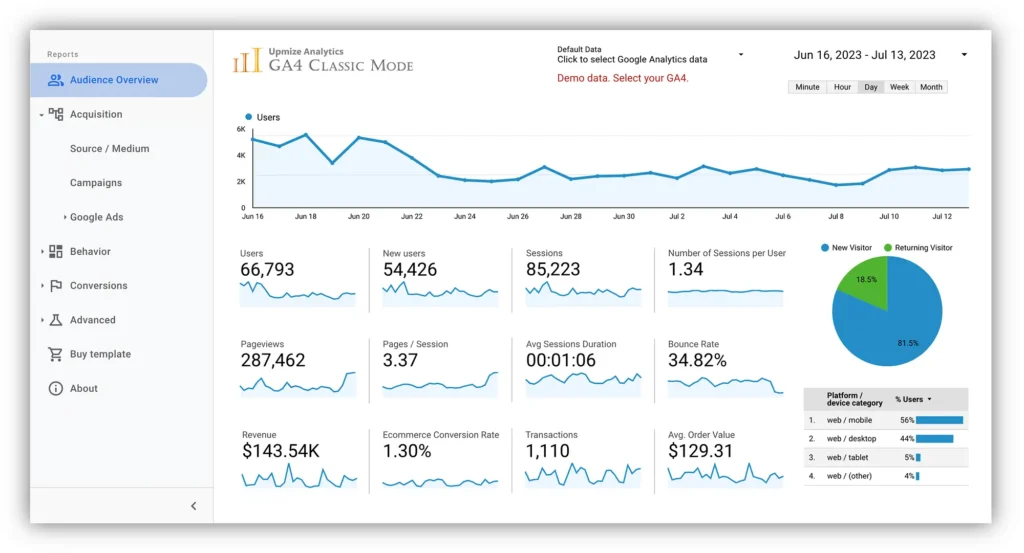
Boosting your eCommerce conversion rate is a massive challenge regardless of what you’re selling. Empathizing with struggles of eCommerce sites, Google’s Enchanced eCommerce provides merchants with richer insight beyond base-level metrics.
Google Analytics can tell you so much more than how many visitors are checking out your site on a day-to-day basis. Representing one of the best eCommerce analytics tools out there, Google Analytics and its Enchanced eCommerce capabilities can help merchants close the loop for new and returning customers alike.
Benefit from Flowbox’s advanced analytics to drive better eCommerce results. Book a demo of our platform today to learn more.
For those looking to go beyond the realm of Google for their analytics, Matomo is an open-source option for tech-savvy merchants. Matomo emphasizes the need for eCommerce sites to be in control of their own data. Unlike Google Analytics, Matomo is installed directly on your servers and isn’t hosted remotely.

Although the platform boasts many of the same features as Google Analytics, Matomo’s eCommerce analytics emphasize features such as…
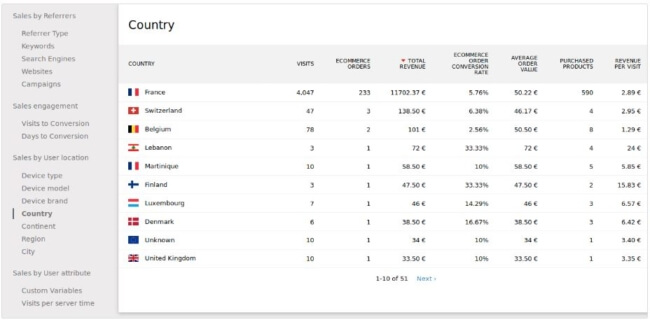
A totally free alternative to Google Analytics, Matomo is a solid option for merchants searching for the best eCommerce analytics tools that don’t want to break the bank.
What about marketers in need of reporting that’s a bit more advanced? From how many times a specific visitor has checked out your site to how often they visit a product page, Kissmetrics emphasizes reporting that drills down to individuals rather than the broad strokes of your traffic.

Kissmetrics’ granular analytics are ideal for brands looking to remarket to their massive audiences and determine which specific marketing channels have the highest ROI. This advanced segmentation can help you figure out what campaigns are performing and which aren’t. For example, the platform allows users to see the lifetime value and churn rates of specific campaigns in a single click.
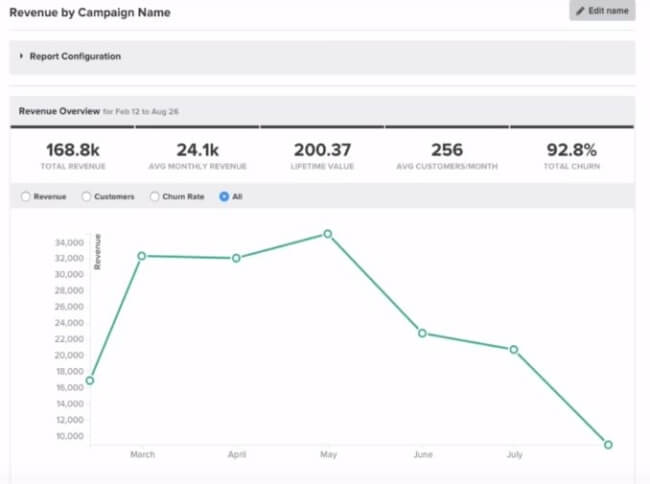
Kissmetrics also delves into the design aspects of your site to help improve conversion rates. The platform allows merchants to create and trigger pop-ups, lightboxes and notifications to discourage visitors from bouncing.
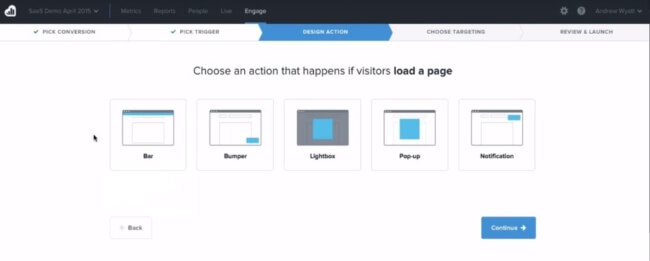
You can then customize, segment and preview what those triggers look like in real-time to your traffic. This provides awesome opportunities for A/B testing.

The platform’s reputation as one of the best eCommerce analytics tools doesn’t come without a price tag. That said, comparing its advanced capabilities to that of Google Analytics or Matomo is comparing apples and oranges. For those with the budget, Kissmetrics’ capabilities could be a potential game-changer.
Marketers can’t afford to make many assumptions in regard to their storefronts. The best way to fine-tune the usability and improve your on-click-through and conversion rates is by stepping into your visitor’s’ shoes.
Heatmapping platforms such as Hotjar are incredibly valuable to modern merchants. Hotjar essentially provides a bird’s-eye view of what your visitors see on-site.
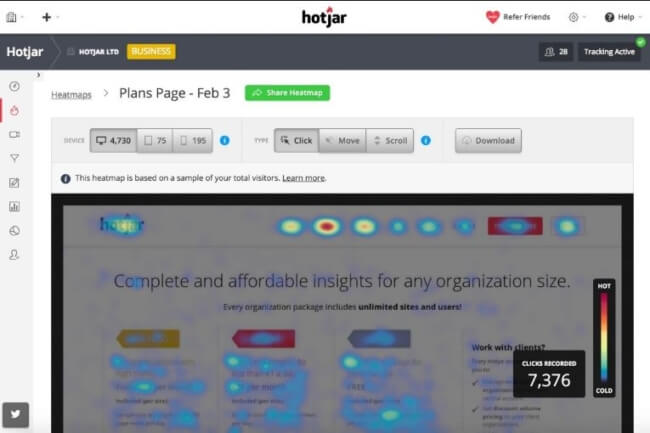
In addition to heatmaps, Hotjar also has the ability to create recordings of real-time visitors. Watching these recordings back provides actionable insight toward improving your conversion rates across your entire site.
At a glance, understanding the behavior of your visitors in terms of tracking and clicks allows marketers to…
In fact, Hotjar themselves identified how one of their eCommerce clients increased their conversion rate by 30% thanks to some small tweaks. Based on information gathered from their heatmaps and recordings, it was discovered that their shopping cart was suffering from login and browser-specific issues that may have otherwise gone undetected by a typical analytics platform.
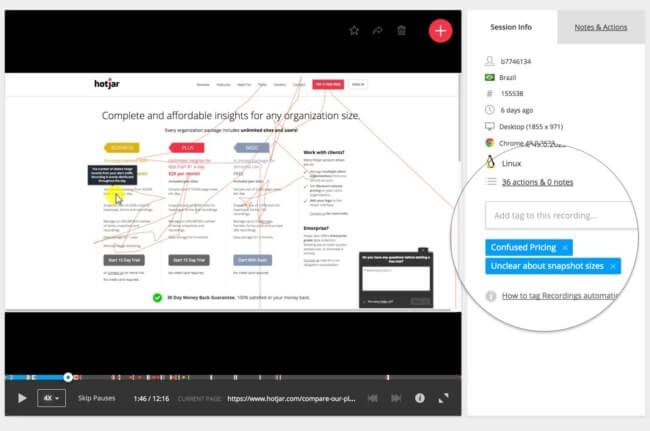
As the old saying goes, seeing is believing. That’s why the best eCommerce analytics tools offer a visual representations of your visitors’ behavior alongside in-depth data.
In eCommerce, there’s nothing worse than an abandoned order.
Maybe you made your visitors jump through too many hoops. Perhaps there was something about your pricing or copy that turned a potential buyer off.
Either way, cart abandonment plagues eCommerce merchants en masse. The average rate of abandonment sits around 70% as lost orders remain one of the most notorious uphill battles for eCommerce merchants to fight against. That’s why solutions such as Woopra have emerged specifically to combat the plague of shopping cart abandonment.
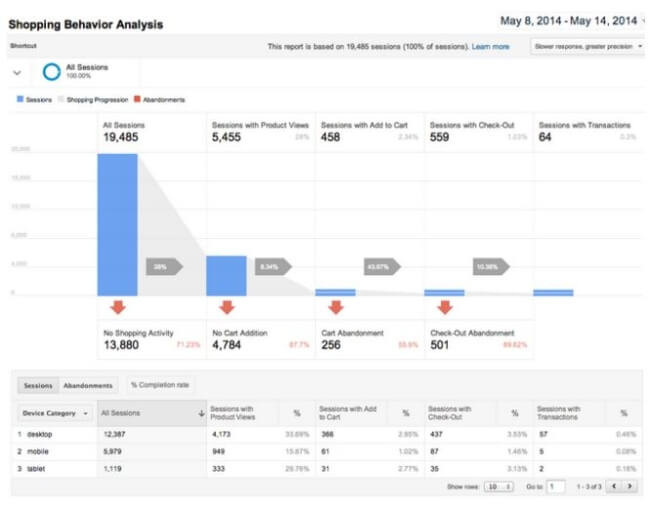
Woopra’s eCommerce analytics stress the concept of “checkout success”, zeroing in on dropoff points in addition to how long it takes for customers to buy. By looking at the abandonment rate basic on specific actions such as adding shipping or payment, it’s crystal clear which aspects of your funnel require your attention.
The platform also generates individual profiles which clue you in on your most valuable customers and how exactly they interact with your store or sales team.
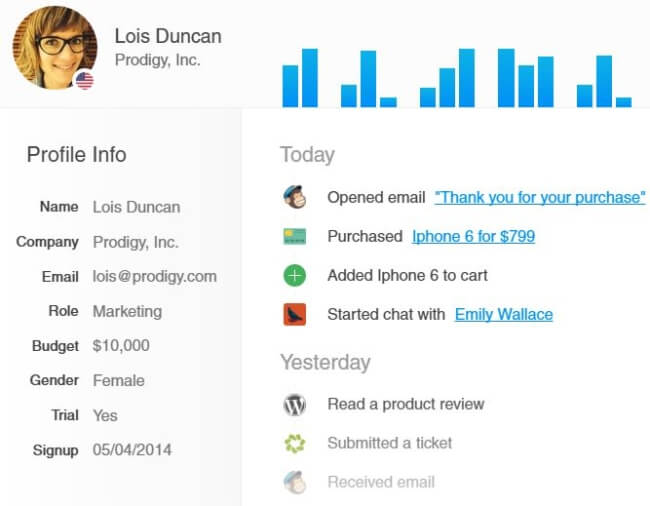
Between Woopra and the other contenders on this list, the common thread between the best eCommerce analytics is clear: encourage your visitors to spend money instead of bouncing.
The best email marketing campaigns tend to feature automation. Whether you’re looking to nurture leads or build a list of repeat customers, email automation is the cornerstone of any eCommerce empire.
However, the biggest names in email marketing don’t always boast the best eCommerce analytics tools. After all, eCommerce marketers require heavy segmentation, a wide variety of messages and plenty of frequency in order to run their campaigns effectively.
Brands therefore also require robust email analytics based on their specific needs. Kalviyo is an email automation and analytics platform specifically tailored for eCommerce merchants. They pride themselves on offering in-depth analytics for eCommerce versus the likes of Mailchimp or other big-name email brands meant for beginners.

But what separates Kalviyo apart from the pack in terms of email analytics? Beyond emphasizing simplicity and not having to sift through endless spreadsheets, the platform’s benefits and features include…
Finally, Kalviyo stresses the need for eCommerce marketers to focus on revenue versus mere clicks. In other words, the financial ROI of your email marketing campaigns for your eCommerce storefront should always be front and center.

A key takeaway here is that you not only need the best eCommerce analytics tool for your storefront or website, but also for your email campaigns as well. eCommerce brands must emphasize analytics across all channels if they truly want to learn as much as they possibly can about their traffic and customers.
Optimizing your eCommerce site or storefront is an ongoing process that never truly ends. This is especially true if you’re consistently running A/B tests to experiment and tweak your poorly-performing pages.
Unfortunately, many marketers fail to understand just how complex and time-consuming A/B testing can be. If you aren’t paying attention to the proper metrics or understand what needs to change, you could actually hinder your earning potential. As a result, platforms such as Visual Web Optimizer are ideal for businesses looking to tune up their marketing campaigns and essential pages with ease.
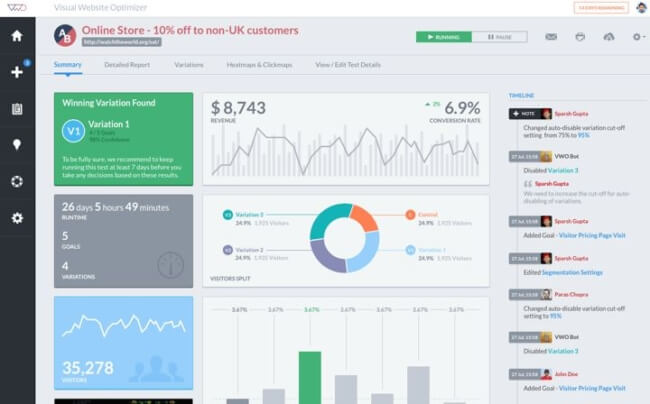
VWO is near-turnkey solution for A/B testing. The platform allows you to create variants of your headlines, buttons, imagery and other key elements to generate multiple iterations of your site. By equally dividing up your traffic, you can determine in real-time which variant of your site results in the most clicks, conversions and time spent on-site. Through a custom analytics dashboard, you can easily see how your variants stack up against each other.
Furthermore, the platform allows users to segment their traffic, personalizing your site based on your visitors’ background. In other words, different visitors will be served the highest-performing variation of your site based on their demographics, geolocation and where they came from off-site (Facebook, Twitter, email, etc).
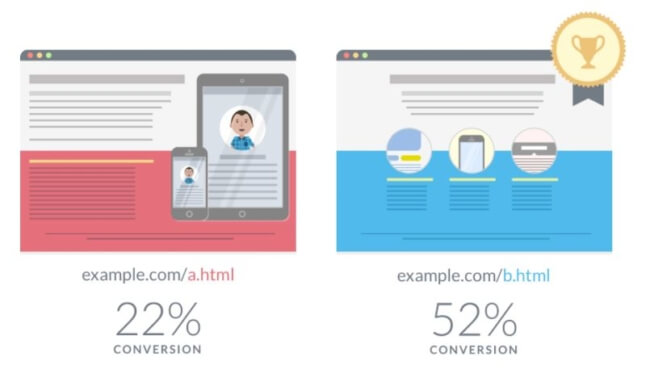
VWO notes that Amazon has dominated eCommerce through their emphasis on personalization and that modern storefronts should therefore do the same. Personalization and optimization are both becoming increasingly important for brands looking to increase their sales.
Last but not least, we can’t talk about the best eCommerce analytics tools without a bit of self-promotion, right?
Flowbox understands firsthand the benefits of User Generated Content. User-submitted and customer photos are arguably proven to boost conversion rates and outperform traditional ads in terms of clicks and engagement. Whether through UGC campaigns on Instagram, customer lookbooks on-site or a embedded Instagram feed, or a shoppable Instagram feed marketers are finding creative ways to use their own audience to win more customers.
That said, you also need an analytics platform that clues you in on your best-performing photos, hottest products and brand evangelists. That’s where Flowbox’s advanced analytics come in.
Flowbox’s analytics ensure that you squeeze the most out of your UGC campaigns by…
Why do these metrics matter? For starters, you can you better determine the types of photos and products that resonate the most with your audience and push those photos harder on social media. Furthermore, you can use your best photos as ads throughout your email campaigns, marketing materials and on-site content time and time again.
In short, breaking down your UGC by the numbers can be potentially transformative for your eCommerce business at large when engaging your audience and winning over new customers.
Want to learn more about our leading UGC platform? Book a demo today to discover what Flowbox can do for you.
Marketers obviously have different wants and needs in terms of analytics tools. Comparing the goals, KPIs and sales strategies of a high-end sneaker brand to someone selling a SaaS product may very well be night and day. Even so, there are common threads between all businesses looking to make the most of their analytics.
In closing, the best eCommerce analytics tools should be…
Easy to use. Integrating your analytics platform with your website or storefront shouldn’t be a headache.
Concise. There’s nothing worse than stumbling over your words while trying to explain your data to a colleague, client or customer. Modern analytics tools are obviously powerful in terms of what they can do. However, your tools should also be able to display your brand’s data in such a way that it’s easy to digest for those outside of your marketing team.
Comprehensive. The more data you have on hand, the better. Again, metrics such as conversion rate, repeat orders and customer lifetime value are among the most important for you to track. Ideally, you have the tools on deck to analyze all of the above to help you make more informed marketing decisions.
Understanding your metrics is the ultimate difference-maker for modern marketers and merchants alike. We hope our list of the best eCommerce analytics tools can assist your business its quest for more traffic, sales and satisfied customers.